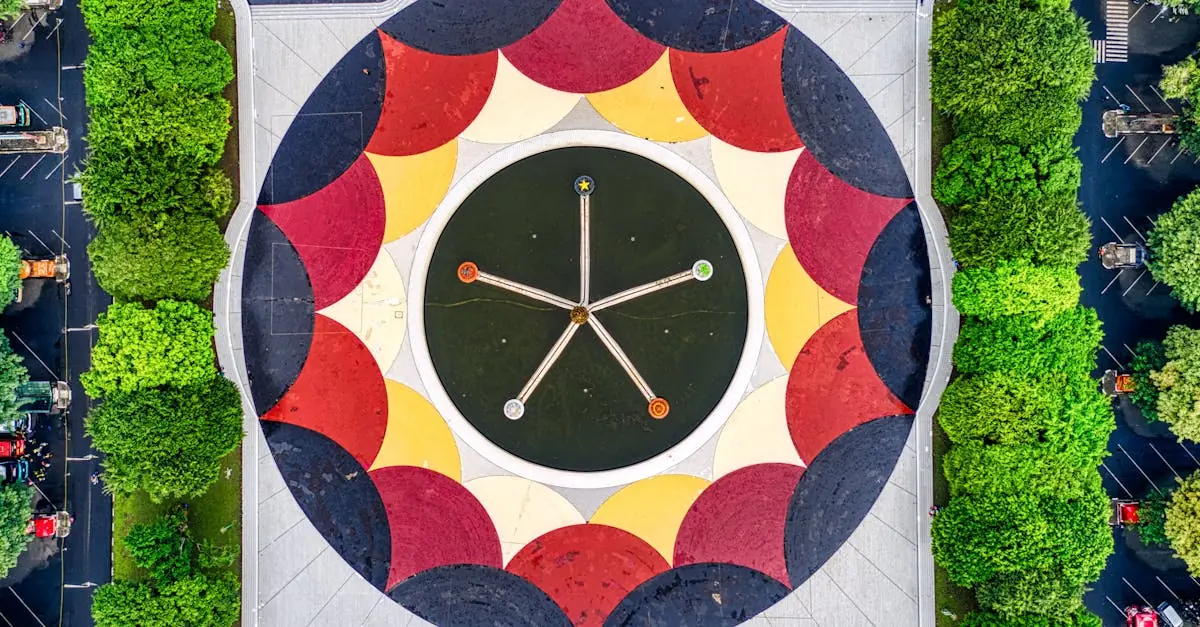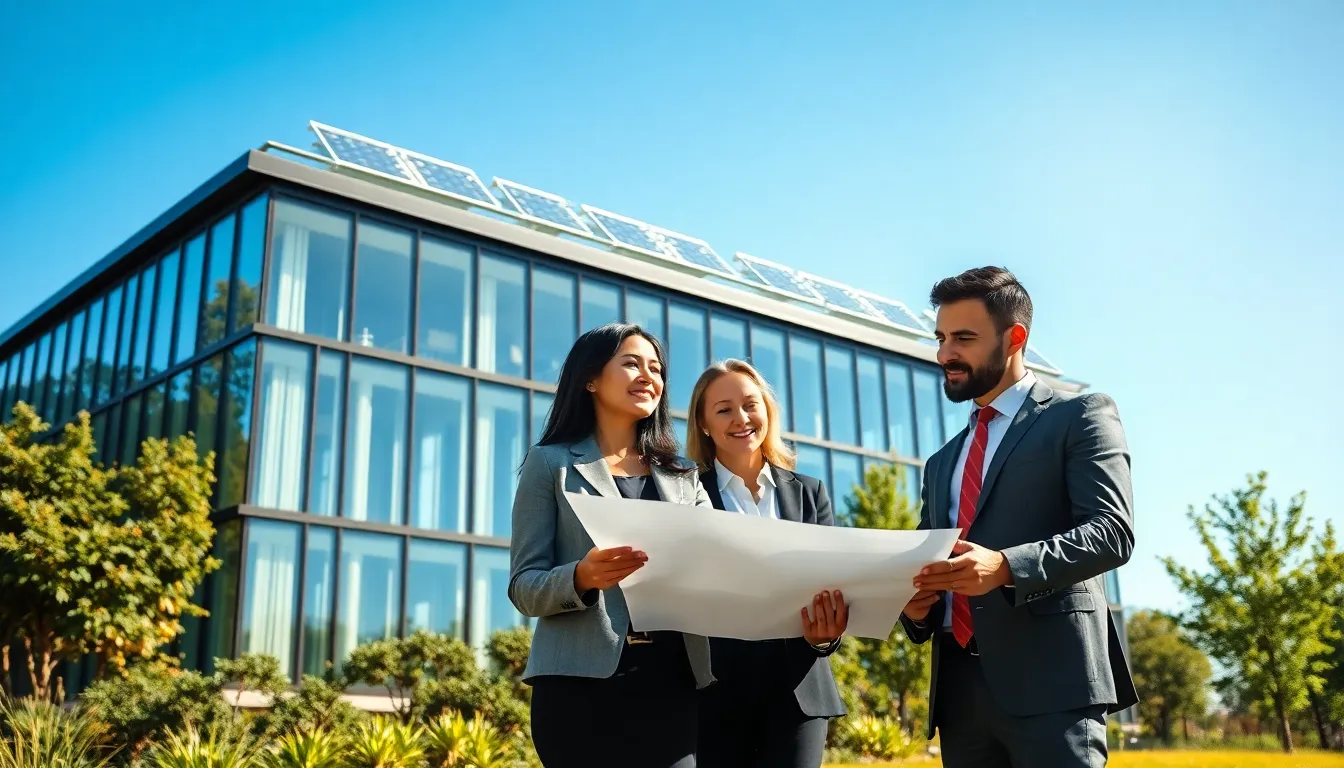Table of Contents
ToggleImagine a world where rooftops aren’t just a place to toss your old pizza boxes but thriving ecosystems that help combat climate change. Enter green roof systems, the unsung heroes of urban architecture. These living roofs not only add a splash of greenery to concrete jungles but also offer a buffet of benefits that’ll make even the most skeptical city dweller raise an eyebrow.
Overview of Green Roof Systems
Green roof systems consist of layered assemblies that integrate vegetation into building rooftops. These systems enhance biodiversity by providing habitats for a variety of plants and wildlife. Unlike conventional roofs, green roofs utilize soil and vegetation to improve air quality. The layers typically include a waterproof membrane, drainage system, growing medium, and plant selection.
The benefits of green roofs include reduced urban heat islands. They absorb sunlight, providing insulation that decreases energy costs for heating and cooling. Water management improves through stormwater reduction, as these roofs can retain rainwater, mitigating flooding risks. Studies show that green roofs can lower ambient temperatures by up to 6°F in urban areas.
Types of green roofs fall into extensive or intensive categories. Extensive green roofs require minimal maintenance and consist primarily of lightweight vegetation. Intensive green roofs accommodate larger plants, trees, and even gardens but demand more resources and maintenance.
Plant selection determines the effectiveness of green roof systems. Drought-resistant species thrive in these environments, offering various aesthetic options. Native plants often provide the best habitat support while ensuring sustainability.
In addition to environmental gains, green roofs contribute to improved building aesthetics. They enhance urban landscapes by transforming bare rooftops into vibrant living spaces. Property values can increase due to the appealing appearance and functionality of these systems.
Green roof systems represent a forward-thinking approach to urban planning and sustainable development. The integration of nature into urban settings proves beneficial for both the environment and the community.
Benefits of Green Roof Systems
Green roof systems offer numerous advantages, contributing notably to environmental sustainability, economic savings, and improved social dynamics in urban areas.
Environmental Benefits
Green roofs enhance urban biodiversity, providing habitats for various native species. They effectively reduce the urban heat island effect, with studies showing reductions in ambient temperatures by up to 6°F. Air quality improves significantly as plants filter pollutants, leading to cleaner urban environments. Additionally, these systems absorb rainfall, helping manage stormwater and decrease flooding risks. Retained water nourishes vegetation while also insulating buildings, reducing energy costs for heating and cooling. Overall, green roofs facilitate the integration of nature into built environments, proving essential for eco-friendly urban planning.
Economic Benefits
Green roofs present compelling economic incentives by lowering energy costs, which can decrease heating and cooling expenditures significantly. Studies indicate that energy efficiency can improve by up to 30% due to natural insulation properties. Maintenance costs often remain low due to the choice of drought-resistant plants. Property values may rise as aesthetics improve, attracting potential buyers or tenants interested in sustainable features. Moreover, these systems can enhance the lifespan of roofing materials by protecting them from UV damage and extreme temperature fluctuations, leading to lower long-term maintenance costs.
Social Benefits
Green roofs contribute positively to urban communities by creating accessible green spaces that encourage social interaction and well-being. They provide recreational areas for residents and promote mental health through exposure to nature. Community engagement often increases as residents partake in the care and maintenance of the green spaces. Educational opportunities arise, offering insight into sustainable practices and environmental stewardship. Furthermore, aesthetically pleasing roofs can improve neighborhood appeal, attracting visitors and enhancing community pride.
Types of Green Roof Systems
Green roof systems are primarily classified into two categories: extensive and intensive. Each type offers distinct features and advantages.
Extensive Green Roofs
Extensive green roofs require minimal maintenance and utilize lightweight vegetation. These systems typically feature shallow growing mediums, usually ranging from 2 to 6 inches deep. Due to their lower soil depth, drought-resistant plants thrive best, allowing them to survive harsh weather conditions. These roofs are ideal for flat or low-sloped surfaces, as they do not require structural reinforcement. Benefits include increased insulation, rainwater retention, and reduced energy costs. Extensive green roofs also support local wildlife, enhancing urban biodiversity.
Intensive Green Roofs
Intensive green roofs accommodate larger plants, trees, and even small gardens. These systems demand deeper growing mediums, generally 6 inches to several feet deep. Higher soil depth allows for a wide variety of plant selections, including perennials and shrubs. More resources are needed for maintenance, irrigation, and structural support, yet the ecological and aesthetic advantages are significant. These roofs foster vibrant green spaces and promote community interaction. Additionally, they improve air quality and provide effective stormwater management, creating a greener urban environment.
Design and Installation Considerations
Design and installation of green roof systems require careful planning and execution. Key elements include plant selection and structural requirements to ensure success.
Plant Selection
Selecting appropriate plants is crucial for green roof functionality. It’s essential to choose species that thrive in local climates and require minimal maintenance. Drought-resistant plants often work well in extensive systems due to their hardiness and shallow root systems. Sedums, native grasses, and succulents represent popular choices for these roofs. For intensive systems, larger plants, perennials, and small trees can enhance biodiversity and aesthetics. Integrating a mix of flowering and foliage plants encourages pollinators. Considering the growing medium’s depth can also impact plant viability.
Structural Requirements
Establishing a green roof involves specific structural requirements. It’s vital to evaluate the existing roof’s load-bearing capacity before installation. Extensive green roofs typically add about 15 to 25 pounds per square foot, while intensive systems can add 50 to 150 pounds per square foot, depending on the soil and vegetation type. A waterproof membrane protects the building from moisture damage. Installing a qualified drainage system promotes effective water management. Engineers often recommend reinforcing rooftops to accommodate additional weight, ensuring long-term stability of the structure.
Maintenance of Green Roof Systems
Routine maintenance ensures the longevity and efficiency of green roof systems. Regular inspections should occur at least twice a year, particularly after heavy storms or harsh weather events. During inspections, check for drainage blockages, plant health, and the integrity of waterproof membranes.
Watering becomes essential during dry spells. Despite vegetation’s drought resistance, young plants may require additional hydration to establish roots. Utilize irrigation systems or manual watering techniques as needed.
Fertilization plays a significant role in plant vitality. Applying slow-release fertilizers in spring supports healthy growth. Organic options, such as compost, enhance soil quality and promote biodiversity.
Weed control ensures native vegetation thrives. Monitoring for invasive species and removing them promptly maintains the ecosystem. Hand-pulling remains an effective method, especially for smaller plants.
Pest management protects plant health. Beneficial insects, such as ladybugs and lacewings, provide natural pest control. If pests become problematic, consider organic treatments that minimize environmental impact.
Pruning larger plants aids in promoting airflow and preventing disease. Regular trimming can also enhance the aesthetic appeal of the green roof. Consider the seasonal growth patterns when scheduling pruning activities.
While extensive systems require less maintenance, intensive systems demand more attention. Intensive roofs may also involve seasonal planting changes or additional plant additions. Assessing the specific needs of the green roof ensures an effective maintenance regime tailored to the design type.
Overall, consistent care maximizes the benefits of green roof systems, enhancing their contributions to urban ecosystems and building environments.
Conclusion
Green roof systems offer a unique opportunity to blend nature with urban architecture. By transforming rooftops into green spaces, they not only enhance biodiversity but also improve air quality and manage stormwater effectively. The aesthetic appeal of these living roofs can elevate property values while creating inviting environments for community interaction.
As cities continue to grow, the integration of green roofs becomes increasingly vital for sustainable urban development. They provide significant energy savings and contribute to climate resilience. With thoughtful design and regular maintenance, green roofs can thrive, making them a valuable investment for both the environment and urban communities. Embracing this innovative solution paves the way for healthier, greener cities.







